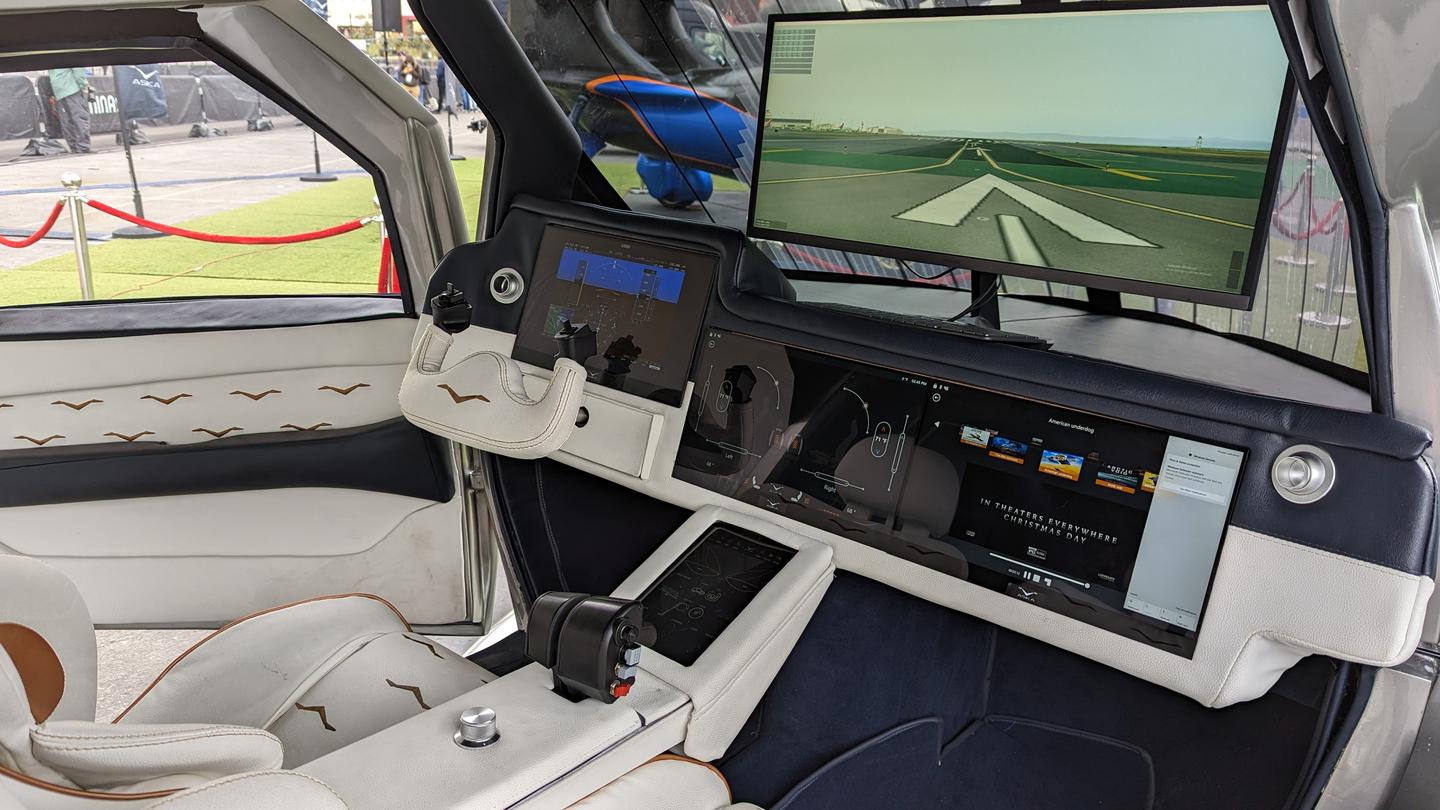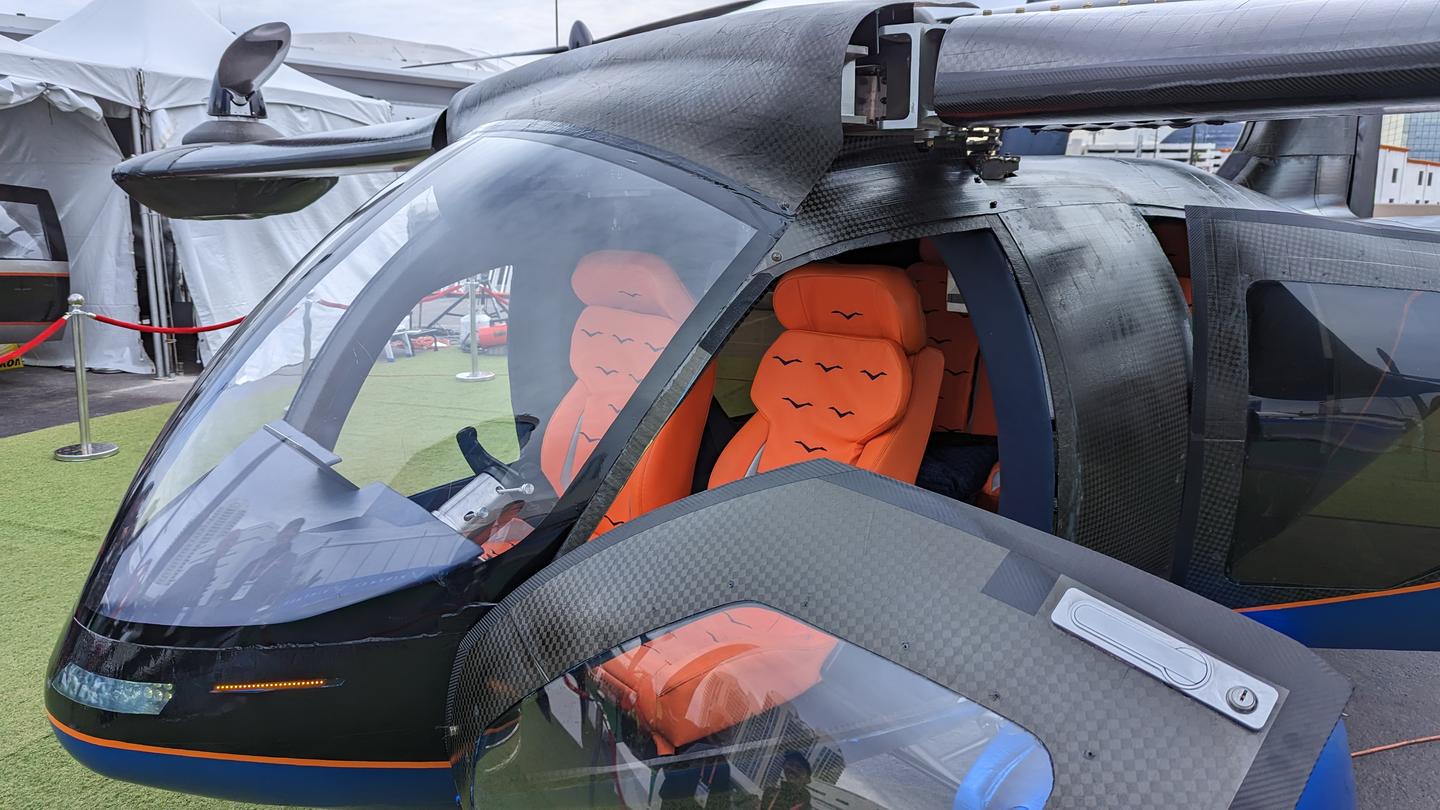Looking like a cross between a helicopter and a fixed-wing airplane, ASKA’s full-scale A5 eVTOL prototype is currently capable of both driving and flying. It stole the show at CES 2023, earlier this month.
I was originally supposed to get to drive the hybrid vehicle up and down the famed Las Vegas Strip. Unfortunately, it was damaged in its transit from northern California, leaving it un-drivable for the show.
However, I did still get treated to an up-close and personal view. I sat inside the cockpit, and I saw the vehicle transform. And with verbal guidance from David, a pilot consulting with ASKA, I flew a virtual version of this futuristic “car” right under the Golden Gate Bridge before proudly landing back at San Francisco airport, courtesy of a flight simulator the company had on hand.

Scott Tharler / New Atlas
Lest you get swept up in the transformational and aeronautical aspects of this vehicle, you might overlook the A5’s innovative wheels. ASKA developed special electric motors for inside each one, the upshot being that the those wheels can take the A5 from zero to about 65 mph (105 km/h) in less than five seconds – equating to needing a mere 250 feet (76 m) of runway – before the propellers take over.
“That’s very cost-effective,” ASKA co-founder and CEO Guy Kaplinsky explained to me. “Because normally if you use the propeller on the runway, it takes a long time to get up to speed.”
In short, this four-seater is capable of either a vertical takeoff and landing (VTOL) or short takeoff and landing (STOL). The beauty is that based on intelligently factoring in the weight of the passengers and any cargo – along with how much runway you happen to have – the aircraft will determine what’s needed, and offer you options for how quickly and expensively you want to get into the air. Picture accelerating onto a highway in a normal terrestrial car … sometimes you have the time and space to gradually merge, and other times – even at the cost of your overall fuel efficiency – you’ve just gotta punch it.

Scott Tharler / New Atlas
The video at the bottom of this article shows how the vehicle transforms from driving to flying mode, where the canard folds forward, the wings fold back and the flaps extend. Then the propellers angle down for liftoff, after which they tilt back to a vertical orientation for forward flight.
The other secret sauce behind making the A5 a reality lies in the hybrid electric vehicle’s power sources. “We couldn’t find a battery that matched our needs, so we had to develop our own batteries,” said Kaplinsky. Those tricked-out lithium-ion batteries, which can be charged at home or via conventional EV stations, combine with a gasoline-powered engine to extend the vehicle’s total range to 250 miles (402 km) at a flight speed of up to 150 mph (241 km/h).
ASKA is working with a few key agencies to get the A5 both street- and air-legal. This effort includes development and flight testing conducted in accordance with the Federal Aviation Administration (FAA) and National Highway Traffic Safety Administration (NHTSA) guidelines for certification. Additionally, the company has signed a five-year Space Act Agreement to advance its participation in NASA’s Advanced Air Mobility National Campaign (AAM), jointly organized with the FAA.

Scott Tharler / New Atlas
The current goal for commercialization is to deliver production models of the A5 and have all the proper regulations and certifications squared away by 2026. In that first phase, only licensed pilots will be able to fly the vehicle. But as soon as 2030, a fully automated version may be rolled out. In the meantime, ASKA anticipates FAA approval of an experimental permit to fly the A5 prototype as soon as this spring (Northern Hemisphere).
With that timeline in mind, the company is currently taking deposits for the limited-run first-edition A5 – those deposits will go toward a hefty US$789,000 total pricetag. But just as the average individual doesn’t own a bus or plane, the idea is to enable everyone to be able to use and share these vehicles. That said, investing in one of the vehicles could allow a family to move out of the city to the suburbs, where the cost of living is significantly lower.
“We started the company not because we want to build an aircraft, [but] because we want to build a solution that reduces the cost of living for people,” Kaplinsky explained. “There’s millions of dollars investing just in infrastructure. But our vision was if we want to reduce the cost of living and improve quality of life, we have to provide transportation.”
In other words, with a current team of around 50 employees working on the myriad systems and solutions necessary to literally make this project take off, ASKA thinks of itself less as a flying car manufacturer and more as a company focused on solving current and future lifestyle challenges. The designers admit, it may not be the best plane or the best car. But Kaplinsky wrapped it up for us neatly by offering, “You get the best ride of both of them when you combine them. That’s the uniqueness of this vehicle.”
ASKA™ A5 drive & fly eVTOL – full-scale functional prototype
Company website: ASKA
Source of Article